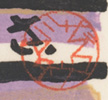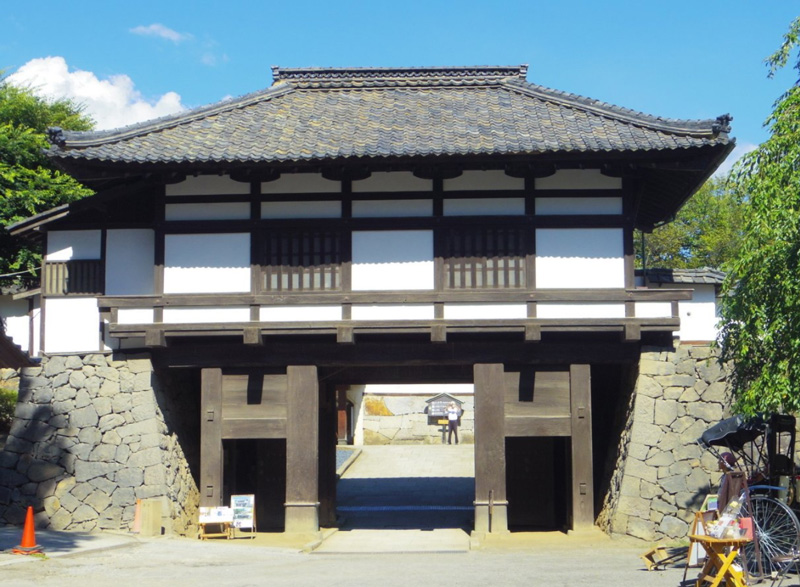About This Print
The San-no-mon Gate at Komoro Castle (Komoro-jō), designated an Important Cultural Property by the Japanese government, is depicted with the city of Komoro sitting beyond the gate with the active volcano Mount Asama in the background. As with all Miyata's prints, this print's beauty is in its abstracted simplicity. This print is number 3 in the third volume of prints titled Shinshū from the artist's 240 print, 12 volume compendium Miyata Saburō Collection of Woodblock Prints Scenery of Japan.
Komoro Castle, located in the city of Komoro in eastern Nagano Prefecture, is listed as one of the "100 Fine Castles of Japan" by the Japan Castle Foundation. The remains of the castle are located within Kaikoen, a park on the site also containing Fujimura Memorial Hall, Koyama Keizo Museum of Art, and a zoo.
A fortification of some sort is said to have stood in Komoro for some time, but the castle took its current form during Japan’s Warring States period in the 16th century. Daimyo Takeda Shingen controlled it for thirty years after seizing control of the area in 1554, ordering his trusted ministers Yamamoto Kansuke and Baba Nobufusa to renovate it for the Takeda clan’s needs.
After the clan was destroyed, the area came under the control first of Oda Nobunaga, and eventually Tokugawa Ieyasu, the first shogun of the Edo period. The castle finally took on its modern form in 1590 under the control of Sengoku Hidehisa, an advisor to Toyotomi, first unifier of Japan (later to be defeated by Ieyasu). The current castle town was also created by Hidehisa. Several decades later, the castle came under the direct control of the Tokugawa family, and as it was in a strategically important location this situation continued for most of the Edo period.
About the Series "Miyata Saburō Collection of Woodblock Prints - Scenery of Japan"
Consisting of twelve volumes, each containing twenty woodblock prints depicting scenic locations around Japan, Miyata spent fourteen years from 1970 to 1984 producing the series, which he carved and printed himself in a limited edition of 100 prints each. Most if not all the places depicted were actually visited by the artist. Miyata followed this massive series of 240 prints with a printed compendium of the prints titled Miyata Saburō mokuhanga zenshū 宮田三郎木版画全集 (The Complete Woodblock Prints of Miyata Saburō), release in limited edition in five volumes in 1983-1984.
Print Details
| IHL Catalog | #1413 |
| Title |  Komoro Castle and Mount Asayama |
| Series | Miyata Saburō Collection of Woodblock Prints Scenery of Japan 宮田三郎木版画集―日本の風景・信州 第三集 (1971年) Miyata Saburō Mokuhanga shū Nihon no fūkei・Shinshū, Collection Number 3 |
| Artist | Miyata Saburō (1924-2013) |
| Signature | none |
| Seal |  |
| Publication Date | 1971 |
| Edition |  百冊限定版の内 (limited edition of 100), as stamped on the left side of the bottom margin |
| Publisher | the artist in conjunction with the Tokyo Print Research Institute Tokyo Hanga Kenkyūsho 東京版画研究所 |
| Printer | self-printed |
| Impression | excellent |
| Colors | excellent |
| Condition | good - mounting tape remnants bottom left margin; minor foxing mainly visible in bottom margin; handling/printing wrinkles |
| Genre | sosaku-hanga (creative print) |
| Miscellaneous | print number 3 in the table of contents of the 3rd volume |
| Format | dai-ōban |
| H x W Paper | 15 1/2 x 20 1/8 in. (39.4 x 51.2 cm) |
| H x W Image | 12 1/8 x 15 7/8 in. (30.8 x 40.3 cm) |
| Collections This Print | |
| Reference Literature | |




